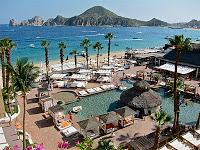Travel Tips
Culinary Experiences: The Truly Local Restaurants of Cabo San Lucas and San Jose del Cabo
Not many travelers head to Los Cabos, Mexico, in search of their next great meal. (The next great margarita, however, is another story.)
But leave it to roving foodie David Latt to discover the authentic finds in Cabo San Lucas and San Jose del Cabo, where travelers can immerse themselves in the local scene, one meal at a time.
Cabo San Lucas has dozens of restaurants worth a visit.
Mariscos Mazatlan, located at Narciso Mendoza at 20th de Noviembre, is worthy of notice as much for the interior as the food, with its soaring, 30-foot ceilings.
The shellfish on the menu is fresh, although rarely caught in local waters.
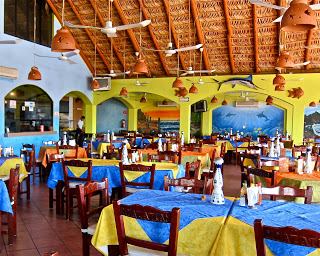 In Cabo, most of the seafood comes from the mainland, especially Mazatlan, just across the Sea of Cortez (also known as the Gulf of California).
In Cabo, most of the seafood comes from the mainland, especially Mazatlan, just across the Sea of Cortez (also known as the Gulf of California).
For appetizers, you can’t go wrong with seafood cocktails made with shrimp, octopus, oyster, or sea conch. Shrimp or fish ceviche, raw clams and oysters or avocados stuffed with shrimp are also a great way to begin a meal.
Fish at Mariscos Mazatlan is served grilled, breaded, fried, and stewed, accompanied simply with pico de gallo or overwhelmed with cheese sauces preferred by many locals.
The specialty of the house is shrimp and they are difficult to resist, cooked a variety of ways, with coconut, tomatoes and chilies, garlic, or potatoes.
If you’re in Mexico, tacos should be a must-eat, but some visitors shy away because of health issues. For a taste of authentic tacos without the worry, try Tacos Gardenias located at Camino al Hacienda and Ninos Heroes.
Housed in a rustic concrete building, with a dirt parking lot on the side, the restaurant is only open from 8 a.m. to 5 p.m. because their customers are usually on the way to the nearby beach or just coming back.
Want to find great places to eat on the road? Visit the Restaurants section.
Locals and tourists (hence the menu in English and Spanish) love the freshly made tacos (shrimp, fish, chicken, pork, beef, fried pork rind, and cactus) and quesadillas (shrimp and chicken).
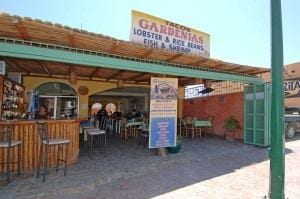 The tacos are served the way locals like them.
The tacos are served the way locals like them.
A homemade tortilla with a topping of your choosing is accompanied with julienned fresh lettuce and cabbage, grilled jalapeño peppers, limes, cilantro and onions, pico de gallo, pickled onions, chile sauce, and squeeze bottles of mayonnaise and hot sauce.
If you order the fish taco (which I recommend), you will be given a fat filet of flounder fried crunchy in a light batter and served on a homemade tortilla. It’s up to you how many condiments you pile on top.
Shrimp is also a specialty, hot or cold. The Molcajete de Camaron, known as the restaurant’s “signature dish,” is brought to the table in a heated, three-legged stone bowl called a molcajete. The shrimp are lightly cooked in a savory sauce made with cheese, onions, peppers. The shrimp cocktail, always served with the Mexican saltine, Saladitas, in their distinctive bright blue wrapper, has onions, cilantro, and a soupy tomato sauce that is irresistible.
This being Mexico, cocktails (margarita, Bloody Mary, Cuba Libre, and tequila shooters) and beer are served all day.
One way to get an overview of the area is to hire a guide for a day. For a little over US$100, companies like Terramar supply not only a guide but a car and driver as well. With a guide you’ll be given an insider’s look at Cabo San Lucas, nearby San Jose del Cabo, and the surrounding area.
Need a free guide to Mexico? Visit Destinations: Mexico & Central America.
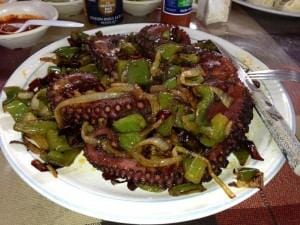 With the help of Terramar’s Enrique Lopez, I discovered El Torito del los Mariscos, located on Janette Wilson 1530 Colonia Ejidal, which is described as “the most popular seafood restaurant for locals.”
With the help of Terramar’s Enrique Lopez, I discovered El Torito del los Mariscos, located on Janette Wilson 1530 Colonia Ejidal, which is described as “the most popular seafood restaurant for locals.”
The menu at El Torito is only in Spanish because although some tourists have discovered the restaurant, this is where the locals go to eat. Their reasons are simple: The food is good, portions are large, prices are affordable, and there is a large children’s play area in back.
El Torito has its roots in Sinaloa where the owners, Jorge and Monserrat Garate have another restaurant in Mazatlan.
Rustic, family style seafood dishes are the focus, with a variety of sauces and a lot of deep frying.
In fact, the most popular dish at the restaurant is the deep-fried bacon wrapped shrimp with cheese. The gastronomically incorrect shrimp are surprisingly light and delicious, not to mention soul satisfyingly crunchy.
Ceviches are popular, as are aguachile, in which raw shrimp, fish, octopus, and squid are “cooked” by a sauce made with limes and Serrano chiles.
Everything at El Torito is handmade. All the salsas, sauces, and tortillas are made according to Monserrat’s recipes as she taught them to Jorge, who is the executive chef.
Want to get the inside scoop on a destination? Try the Ask the Locals Guides.
What distinguishes El Torito from other seafood restaurants is the size of the portions.
When you order a shrimp cocktail from another restaurant you will be presented with a glass goblet filled with peeled, deveined shrimp. Here a dozen or more large, unpeeled shrimp with their heads still on are perched on the rim of a molcajete, the bowl filled with a sweet-hot-salty tomato sauce flavored with chunks of onion and pieces of fresh cilantro. You’ll get your hands dirty when you eat here and you won’t mind a bit.
El Torito opened five years ago as a small, concrete block, cantina-style shack, with no more than a dozen tables. In December, the restaurant will move to a larger space next door. Even though the interior will be more finished, El Torito will keep the cantina feeling with open spaces beneath an elevated roof, even in the bathrooms. Besides good, affordable food, what keeps the restaurant popular is the friendly staff and the feeling that even though this is a restaurant, you’re being served as if you were at home.
Twenty minutes to the east, San Jose del Cabo is the exact opposite of Cabo San Lucas.
Where one is big, bold, noisy, sexy, and modern, the other has its identity sunk deeply in the history and traditions of the area. The Plaza Mijares and Mission San Jose del Cabo anchor the downtown with its narrow streets, many restaurants, and small stores selling jewelry, handmade local goods, and quality art.
Learn more about San Jose del Cabo from David Latt: Cabo San Lucas Vs. San Jose Del Cabo: Adventures in Baja California
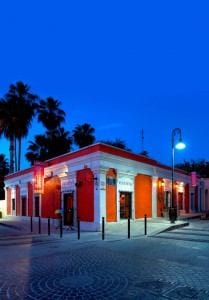 The authenticity of the city is reflected in the decor and menu of Salsitas, at Alvaro Obregon 1732, an intimate bar, restaurant, and art gallery open for lunch and dinner on the border of the historic Art District.
The authenticity of the city is reflected in the decor and menu of Salsitas, at Alvaro Obregon 1732, an intimate bar, restaurant, and art gallery open for lunch and dinner on the border of the historic Art District.
The specialty cocktail of the restaurant takes two hands to drink. Served in a large clay bowl filled to the brim, a very generous helping of reposado tequila (aged between 2 and 11 months) is flavored with slices of grapefruit, orange, and lime and chilled by a handful of ice cubes.
On a warm evening, the refreshingly cool drink was the perfect accompaniment for the chips and four salsas that started the meal.
The other appetizer was a traditional Mexican taste treat: deep-fried peppers stuffed with tuna, seasoned with lime.
Even if you aren’t hungry or thirsty, Salsitas is a great place to stop and enjoy the colorful rooms and beautiful Mexican art.
Also open for lunch and dinner, La Panga Antigua Restaurant & Bar is an intimate restaurant with a reputation for friendly service and quality food.
The dinner menu is somewhat pricey, but the prix fixe lunch menu, with a starter, entree, and dessert is a bargain at under US $20.
After a long morning walking around the Art District, La Panga’s shaded patio offered a good meal in a pleasant setting.
Also in Baja California: one of the 5 Unexpected Gay Pride Festivals.
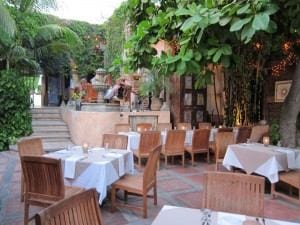 The organic green leaf lettuce salad with grilled whole cherry tomatoes (a nice touch), escabeche pickled onions, and cracked pepper dressed with a honey vinaigrette was delicious. A basket of freshly baked grilled focaccia bread with onions and basil went well with the salad and the entree: a pan sauteed, salt crusted white fish (basa) with roasted new potatoes and mixed vegetables (carrots, asparagus, bell peppers, and zucchini) and basil-oil dipping sauce.
The organic green leaf lettuce salad with grilled whole cherry tomatoes (a nice touch), escabeche pickled onions, and cracked pepper dressed with a honey vinaigrette was delicious. A basket of freshly baked grilled focaccia bread with onions and basil went well with the salad and the entree: a pan sauteed, salt crusted white fish (basa) with roasted new potatoes and mixed vegetables (carrots, asparagus, bell peppers, and zucchini) and basil-oil dipping sauce.
A bit less salt on the fish would have been preferable, but the dish was otherwise well-prepared and delicious. Dessert was a light cheese cake with caramel and fresh strawberries. A cafe con leche caliente finished the meal.
If you can stay in San Jose Los Cabos for dinner, make reservations at Don Emiliano Restaurant at Boulevard Mijares 27, where Chef Margarita C. de Salinas presents dishes she describes as “Mexican haute cuisine,” with traditional ingredients benefiting from the chef’s training at the Culinary Institute of America and Le Cordon Bleu.
Expect to spend several hours enjoying a meal in the lovely courtyard, sampling not only dishes from the menu but premium Mexican wines from their extensive cellar.
More casual, Tequila Restaurant has a small dining room just inside the front door.
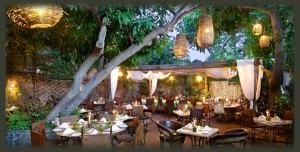 But the main dining room is in the large courtyard at the rear of the building, shaded by giant avocado, mango, African tulip, and guava trees planted in the 1920s.
But the main dining room is in the large courtyard at the rear of the building, shaded by giant avocado, mango, African tulip, and guava trees planted in the 1920s.
Lights hung in the branches create the feeling of a place out of time.
Trained as an agricultural engineer, Enrique Silva, chef and co-owner with Fernando Hernandez, opened the restaurant in 1996 because he wanted to serve organic, locally sourced food.
He buys much of his seafood from the fish market at Puerto Los Cabos, the nearby fishing village, with the rest bought from fisherman who sail out of Palmilla and La Paz and Puerto San Carlos on the Pacific.
Most of his produce comes from his own certified fair trade, organic farm called Huerta Los Tamarindos, just outside of town. He grows herbs, lettuces, arugula, heirloom tomatoes and many varieties of peppers. Because he has his own farm he can cook with fresh guajillo and cascabelpeppers, typically only available dried.
According to Silva, farms in lower Baja California have been growing organic produce for 30 years. The area is a pioneer in Latin America, where farms began by growing herbs and then vegetables, and has evolved into a hundred-million-dollar business.
Since he never went to culinary school, Chef Silva didn’t learn how to make stocks, but rather learned to use fresh ingredients and herbs to create food that tastes fresher and lighter.”
Find more great eating experiences, visit our Culinary Travel section.
The menu proudly features fresh produce from his farm in the many salads.
Seafood and vegetables are prepared Italian style, grilled and flavored simply with olive oil and fresh spices. A Mediterranean bias appears in the use of rosemary, the inclusion of pastas and risottos, and fish baked with wine and basil.
The tequila shrimp locates the dish thoroughly in Mexico with tequila sauce and sides of plantains and black beans. The large shrimp were sweet and delicious. A braised octopus used the fresh guajillo peppers from the restaurant’s farm, together with chilies and garlic in a dark, rich sauce.
While the food at all these restaurants is good and definitely better and (mostly) less expensive than what is offered at the hotels, the additional pleasure is in the setting. Adding to the appeal of good food is the pleasure of Salsitas’ art-filled, colorful interior, the open, casual cantina feeling of El Torito, Mariscos Mazatlan’s deep blue walls with their fish-filled scenes, and the lush landscaping of the patios at La Panga Antigua and Tequila Restaurant.
At any one of the restaurants I visited, I could easily spend hours with friends, eating, drinking, and hanging out in the welcoming environments.
To learn more about travel, food, and culture in Mexico, check out:
- Cabo San Lucas Vs. San Jose Del Cabo: Adventures in Baja California
- Driving Vacations & ATV Adventures: Cabo San Lucas to Buena Vista – Baja California
- Mexico & Central America Travel section
- Ask the Locals Travel Guides section
- Ask the Locals Travel Guide: Punta Mita & Riviera Nayarit, Mexico
- Cabo San Lucas Resorts Brace for Hurricane Jimena
Text and photos by David Latt for PeterGreenberg.com. Visit David on the Web at MenWhoLiketoCook.com.










